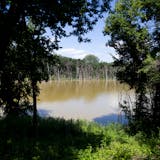Another invasive species is showing up on recreational lakes, one that could become more insidious than zebra mussels or curly pondweed. They're brightly colored, ear-pounding loud and more powerful than most cars. Unlike pondweed, these things affect lake bottoms, lake surfaces and lakeshores.
They're wakesurf boats, the hottest-selling watercraft in Minnesota and Wisconsin. The pricey rigs are specially built to create 2-foot waves, cresting ever higher with newer versions.
Starting a few years back, boats were fitted with ballast tanks to push their sterns down and churn big waves for steeper launch for wakeboarders to fly and twist and flip.
But like most things in a bigger-is-better culture, the little-noticed wake boats started growing ever longer with larger ballast tanks sucking in a ton or more of water with ever-larger engines and boombox speakers sending mega decibels of rockin' tunes bouncing across water, invading entire shore-land neighborhoods, like it or not.
Waves soon became so big that mostly young hotshots could surf without a tow rope. Wake boats became wakesurf boats. Underneath, adjustable stabilizing flaps can better build and shape waves to, among other things, sync to the skill of the boarder and even to suit left- or right-footed surfers.
Next up are surf pontoons with plush seating atop 25-foot platforms that carry up to 20 partiers who sometimes gather strategically on deck to build still bigger waves to complement those created by ballast tanks now holding two-plus tons of water. Engines up to 450-horsepower propel the whole shebang. It could be yours for $150,000 to $200,000-plus, with each fill of marina gas topping $300.
But waves of another sort are rising ("Wake boats churn up controversy on lakes," front page, July 19) — fast-growing concern and ripples of rage over what happens as wakesurfers pass and their residual: huge waves whose spreading path leave fishing boats, runabouts, pontoons and kayaks rocking, often wildly. Near shore, the waves rile bottom sediments and re-suspend harmful nutrients, especially phosphorus, that promote unwanted algae growth.
Deafening music, often replete with crude lyrics, pound the shore. As the boats move from lake to lake, leftover ballast transports invasives like zebra-mussel larvae.


